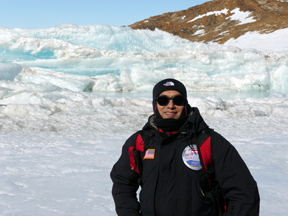The wind was howling — reaching a blistering 80 miles per hour — and the temperature was cold.
How cold? Try minus-55 degrees Fahrenheit.
 |
| Biology Professor Asim Bej visited Antarctica this past fall to study extremophiles inhabiting the lakes, glacial ice and rocks to see if they possess the key to the treatment and prevention of skin cancer. |
“Well, it was freezing cold,” he says as a smile creeps across his face. “It wasn’t very pleasant, but it was well worth it in the end.”
Bej, professor of biology, got a taste of the Antarctic weather recently when he visited the continent to study extremophiles inhabiting the Schirmacher Oasis lakes, glacial ice and rocks. He was studying the biodiversity of these microbials to better understand how these organisms survive in such extreme environments and to see if they possess the key to the treatment and prevention of skin cancer.
“We have found excellent results in our research so far,” Bej says. “Now I’m looking for more collaboration. I would really like more involvement from UAB scientists, especially when it comes to designing drugs for testing the effectiveness of the compounds.”
Colorful pigments show promise
Bej, who is in his 18th year at UAB, discovered that many of these extremophiles produce colorful pink, yellow, red and purple pigments. His doctoral graduate students Nazia Mojib and Jonathan Huang and UAB chemists Donald Muccio, Ph.D., and Reddy Atigadda, Ph.D., analyzed the chemical structure and concluded the pigments play a key role in helping them survive.
“They live in an environment with high solar radiation, where humans can get sunburned wearing SPF 30 sunscreen,” Bej says. “We’ve discovered that these pigments play very important roles in their survival and help protect their DNA — even in the high solar UV during the summer, when there’s 24 hours of day light.
“We’ve also found these pigments have strong murine anti-melanoma and anti-fibrocarcoma components; in other words, we think they potentially can be used to design chemotherapeutic drugs in the future.”
In fact, preliminary testing has shown that one of the purified pigments is particularly strong in protecting from UV damage. It also has caused cell death of murine skin melanoma cell lines while not harming healthy cells.
“Our tests show no toxic effect at all,” Bej says. “And in our ongoing research, we’ve even found similar results with pigments from many of the other organisms against similar cancer cell lines. It’s a very good agent, it seems. I’m hoping it will be in a drug.”
There have been other successes, too:
• Identifications of previously undiscovered microorganisms are being studied in collaboration with Richard Hoover and Elena Pikuta of the Astrobiology Laboratory at NASA in Huntsville.
• The chemotherapeutic potential of a pigment from a previously undiscovered microorganism is being studied in collaboration with Nabiha Yusuf, Ph.D., and Tahseen H. Nasti in the Department of Dermatology.
• The pigments also have shown promise in destroying tuberculosis cells in preliminary research with Michael Niederweis, Ph.D., and his graduate student Rachel Philpott in the Department of Microbiology.
Funded expedition
Bej was part of a 15-person international team visiting Antarctica this past fall as part of the 2008 Tawani International Antarctic Expedition.
The interdisciplinary team included representatives from the fields of limnology [the study of inland waters], microbiology, paleontology, geology, biochemistry, astro-geophysics, biophysics, molecular biology, astrobiology and medicine. Many of the researchers had worked in Antarctica before, but this was Bej’s first trip to the continent. He spent more than two weeks in the Shirmacher Oasis region.
“Our team is meeting in April in Chicago, and we will show all of our findings to this point,” Bej says. “A new wing at The Field Museum in Chicago called the Center for Meteorites and Polar Studies highlighting this and previous Tawani-sponsored expeditions is scheduled to open during the April meeting. Another expedition is scheduled for 2010, and I’m excited about the opportunity to go back. We’re getting fabulous results so far, but now we need more collaborators.”
Researchers interested in learning more about Bej’s research can contact him at 934-9857 or abej@uab.edu. For more on the Tawani Expedition, visit expedition.tawanifoundation.org.